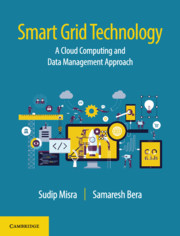Book contents
- Frontmatter
- dedication
- Contents
- Figures
- Tables
- Foreword
- Preface
- Part I Introduction
- 1 Introduction to Smart Grid
- 2 Introduction to Cloud Computing
- 3 Introduction to Big Data Analytics
- 4 Fundamental Mathematical Prerequisites
- Part II Cloud Computing Applications for Smart Grid
- Part III Smart Grid Data Management and Applications
- Part IV Smart Grid Design and Deployment
- Index
2 - Introduction to Cloud Computing
from Part I - Introduction
Published online by Cambridge University Press: 20 October 2018
- Frontmatter
- dedication
- Contents
- Figures
- Tables
- Foreword
- Preface
- Part I Introduction
- 1 Introduction to Smart Grid
- 2 Introduction to Cloud Computing
- 3 Introduction to Big Data Analytics
- 4 Fundamental Mathematical Prerequisites
- Part II Cloud Computing Applications for Smart Grid
- Part III Smart Grid Data Management and Applications
- Part IV Smart Grid Design and Deployment
- Index
Summary
The term ‘cloud computing’ was initially coined to refer to on-demand computing services that were offered by commercial service providers such as Amazon, Google, and Microsoft. Cloud computing is an emerging computation model that shares resources over the Internet and provides on-demand facilities to its customers. In other words, it can be seen as a computation platform combined with shared computer processing resources over the Internet. Computing resources can be shared from anywhere using Internet connectivity. Thus, cloud computing enables ubiquitous and on-demand access to a shared pool of resources to meet users’ requirements [1]. Figure 2.1 depicts an overview of the cloud computing technology.
As depicted in Figure 2.1, cloud computing consists of several shared computer resources, such as computing devices, software, and applications, which are accessed in an on-demand basis. Additionally, different consumers, who access the cloud platform through mobile phones, laptops, desktops, and other peripheral devices, are also present in the cloud computing technological framework. All the resources and consumers are linked through Internet connectivity. The entire framework is part of a cloud platform. Therefore, a cloud platform helps its users to store and process their data in data centers. The important feature of cloud computing is that a central management entity controls all operations associated with different users situated in different geographical regions. Thus, multiple agents can participate in a single platform to share/procure resources in an
on-demand basis. Figure 2.2 shows an abstracted view of the cloud computing technology. The cloud manager maps the incoming requests with the available resources, which are shared with the cloud manager. So, it is evident that the cloud manager only manages the available resources and incoming requests in an optimum manner, so that the users of the cloud-services can get seamless and ubiquitous services. However, the cloud-service subscribers do not know from which hardware/software resources, the requested services are provided. Similarly, the owners of the shared resources also do not know to whom their resources are mapped. Therefore, although a common platform is used for multiple parties, an abstraction level is always used for security and privacy concerns. As evident from Figure 2.2, there are multiple parties that participate in the resource sharing/procuring/managing process – publisher, subscriber, and manager. The publishers publish their shared resources to the cloud-service providers.
- Type
- Chapter
- Information
- Smart Grid TechnologyA Cloud Computing and Data Management Approach, pp. 18 - 37Publisher: Cambridge University PressPrint publication year: 2018



